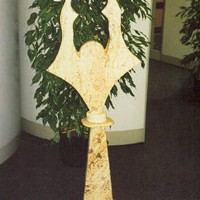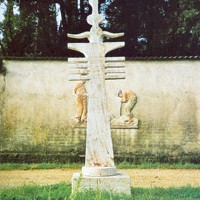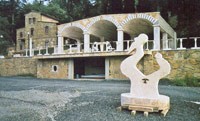Alchemy with nature .
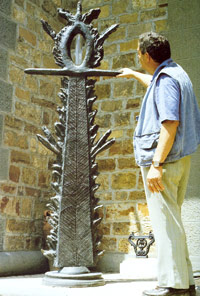 The entrance of the villa’s gate “Le Querciolaie” by Monteverdi Marittimo, there is a sign indicating: “Rolando Stefanacci – sculptor”, the reproduction of some of his sculptures and the phrase “ALCHEMY WITH NATURE “ A binomial that suits him well: that alchemy science Stefanacci is closely examining for many years now applied to the nature of the immense park surrounding the sixteenth-century villa where he found for some time the quietness for his “working idleness”. A park full of secular oaks and ilexes, Mediterranean bush and flowers of any kind “coming out” from the earth giving him that yellow rose tree stone nuance with which he realized many of his sculptures and through which he built up some original little villas immersed into the vegetation, Stefanacci codified for some time his entire work into a monograph embracing it till 1998. A work that in the latest few years has just assumed aspects of great interest for the quality of its product but, most of all, for those esoteric meanings to be subtended and perceived in the components. “Art – says Stefanacci – is alchemy’. He keeps on: “Since the earliest times, just when men began to turn away from their natural state, the artist comprehends that matter is composed of elements. By distilling the colours from vegetables, ground, oxides and mineral he tries to delinea te the forms through representative scenes of events and hieroglyphs to be used as a primordial but universal communication vehicle. He instinctively apprehends ha can use any material, wood and stone, metal and. anything the marvelous universe shares with him. He feel the uncontrollable need to honor those forces that unable and quite force him to compose and decompose, according to his intimist perception, temples, monuments and divine representations”.
The entrance of the villa’s gate “Le Querciolaie” by Monteverdi Marittimo, there is a sign indicating: “Rolando Stefanacci – sculptor”, the reproduction of some of his sculptures and the phrase “ALCHEMY WITH NATURE “ A binomial that suits him well: that alchemy science Stefanacci is closely examining for many years now applied to the nature of the immense park surrounding the sixteenth-century villa where he found for some time the quietness for his “working idleness”. A park full of secular oaks and ilexes, Mediterranean bush and flowers of any kind “coming out” from the earth giving him that yellow rose tree stone nuance with which he realized many of his sculptures and through which he built up some original little villas immersed into the vegetation, Stefanacci codified for some time his entire work into a monograph embracing it till 1998. A work that in the latest few years has just assumed aspects of great interest for the quality of its product but, most of all, for those esoteric meanings to be subtended and perceived in the components. “Art – says Stefanacci – is alchemy’. He keeps on: “Since the earliest times, just when men began to turn away from their natural state, the artist comprehends that matter is composed of elements. By distilling the colours from vegetables, ground, oxides and mineral he tries to delinea te the forms through representative scenes of events and hieroglyphs to be used as a primordial but universal communication vehicle. He instinctively apprehends ha can use any material, wood and stone, metal and. anything the marvelous universe shares with him. He feel the uncontrollable need to honor those forces that unable and quite force him to compose and decompose, according to his intimist perception, temples, monuments and divine representations”.
“But why – we ask – art is alchemy”. “In such an endless research – adds Stefanacci – the artist (the man, as well) sees himself as the fruit of an alchemy process. He as well recognise himself as completely absorbed in the cycle of compositions and decompositions, not quite different from the matter he shaped and from the objects he represented. He perceives in an instant to be, firstly, the work of a sublime artist and eterhal, by that way permeated with the soul essence that vivifies the universe. It is the deep consciousness of the perpetual alternation of compositions and decompositions that makes it possible my own existence, of which art is the supreme expression”.
On the spur of this conception arising from deepen studies on the knowledge (“Better making our own way into darkness – he affirms – instead if stop watching the surface”), Stefanacci has in the last few years got on with the study of the hermetic doctrines, of that “great work’ the alchemy, a word dating back from the earliest times that is, in Greece and in Egypt but That in substance proves to be an hermetic science plunging its basis into the permutation of the forms through the spirit.
With time Stefanacci obtained consents and gratifications for his work as an artist and as a man, too. Among the many to be recalled is a writing by professor Antonio Bagni on the occasion of Stefanacci’s artistic intervention in the cemetery of Agliana in Tuscany where he has decorated a chapel with his wonder fui ceramics. Words that englobe the two aspects, Stefanacci’s artistic and human ones: “For those who can grasp it, the meeting with a person is always – he writes – a creative input to fully uve our own human dimension, both in social and individuaI terms. When you meet Rolando Stefanacci, a complete man and artist, you feel inside a fluid that shakes you interiorly pushing you to find in the mystery of existence the sign of a different way -ancient and new at the same time – to breath life”. When there is not the physical presence of Rolando, there are the revealing glazed visions of his ceramics, which in vite you to the search of the arcane reasons of life. His works, fruit o fan intense and deep reflection activity, whether to comprehend or communicate the reality, trans figure in significant symbols the simplest everyday life facts by enlightening them with lights and colours in perfect symbiosis with nature, with the mystery of its seasons, with the sunbeams and the moonshine”.
“I am lucky – he goes on – to uve in Agliana, a little town between Pistoia and Prato, where Rolando, in sign of friendship and with great generosity, has given some of his works, not for a vain search of glory but to leave a trace, a message to those who will see and be able to read them with pure hearth. In the old Town House, beside the stairs leading to the council hall and in front of the exit of the library, stands out one of his ceramics of about three metres and a half of height and one of width, contained in a great and carved walnut frame, in which is the tali figure of a young man, symbol of Agliana Town Hall (young because of his recent history even though with rural medieval origins). He holds a balance by the arms that is, justice, and a dove that is, peace.
Below is the Town House and a crowd of people running into it: the Town House should be a house opened to the participation of all citizens in order to rule in justice and peace”. Meanwhile, under the gallery outside the Technical Commercial School “Aldo Capitini” in the most important school of Agliana, Rolando left the sign of his love for the young and the culture. To the discovering of his work were responsible the young who read Rolando’s ceramics described in their paper “Here the news!”: the work is 1,70 of height, the feet of the represented young man stand on the terrestrial cap where some biblical scenes are featured; the one on the right side is, with emphasis, referable to the fight between Cain and AbeI told in the Genesis; the one on the left side suggests on the contrary different interpretations: someone in fact saw in it the jewish people led by Moses to the Mount Sinai in search for the Tables of the Laws; others the procession of the shepherds to Bethlehem in search for the hut of the Saviour announced to them; in the end someone eke, by reading this image, sees in it the humanity that, from the StoneAge on, walks towards the future and progress.
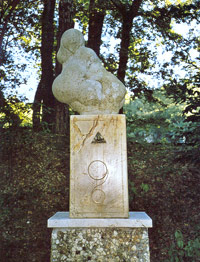
“L’abbraccio” (Collezione privata
Adholph Broderix)
The young man standing in there, simply dressed and with absorbed air, holds two objects by the hands: on the left one, the book of the divine Law, on the right one the balance representing justice, or, the cultural, historical, religious equilibrium between the people that, unfortunately, are not currently ruled by humanity. The perfect alignment of the two plates represents the wish that the nowadays’ fragile equilibrium becomes stable and lasting in the future. The “Capitini” students concluded this way their article: we hope the presence of this sculpture in our school will be an invitation for everybody to the contemplation of our elves, nature, art and life “.
“In the chapel of the new cemetery “The Garden” in Agliana, Rolando left a big message of hope. Leonetto Tintori, painter and restorer Pra tese, who Is well known in the artistic background, explains the meaning:
con firms his willingness to the renewal and exploitation of the deepest human feelings by proposing a meditation on moral and artistic values of fundamental importance. The general concept on which the decoration is based consists in the serene vision of human life from the beginning to the end. At the centre of the Chapel’s pediment, on a red-tiled background, a big egg is standing, which is the symbol of life: from the white uncovered celi comes out, new-born, the man. On the right wall inside, is standing, slim, Eva, who is lavishing numerous human beings with natural prolificacy. In front of Eva, on the left wall, Adamo advances with steps made safer by the promise of justice being entrusted to him. Behind the altar, on the front wall, Is the representation of life at sunset with the shadow of the sacrificial wood. The spirit of the dead stirs on the valley aspirating to the reunion with the luminous universe. On the entrance wall the pelican, symbol of love and sacrifice, concludes the itinerary of the limpid shades of the enamel.
“So, also in a piace that Is usually deputed to the contemplation of death, Rolando talks us about life through the symbols of a nature purified by love, in its ascensional motion to the Holy Spirit who, in the sky of the Chapel, supervises and wait.
- “L’energia creativa”( Collezione Dr. Peter Moratin)
- “Fonte con pianeti” (laterale)
- Fonte con pianeti dell’universo” (Travertino e onice)
It is the vital fluid of Rolando who, through the rarefied light of his ceramics, is and will always be present in Agliana to invite us to seek the harmony of life in the mystery “.
Here, looking for the harmony of life in the mystery: all the symbolism that Stefanacci proposes in ceramics, sculptures and in the distant past in paintings, tends precisely to this, to seek the balance of our existence through the ancient secrets of hermetic philosophy.

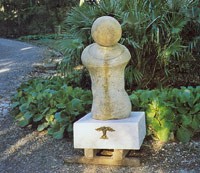


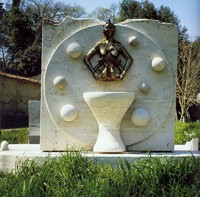
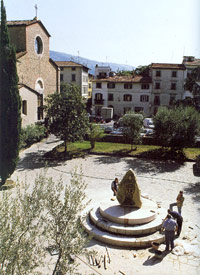
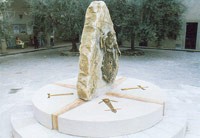
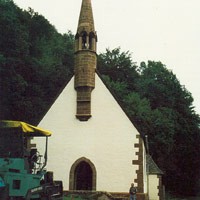
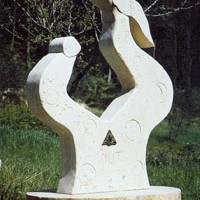
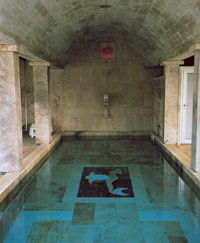 In the great park surrounding the “Querciolaie” Stefanacci has built several small villas in the same stone in which he creates his sculptures, immersed in nature and adorned with the artist’s ceramic decorations and alchemist symbol. A haven for visitors, revered in an article published in the magazine “Tutto Agriturismo”, a guide to the pleasures and culinary delights of farm holidays. The front cover issued a photograph of the charming interior of one of the villas bearing the unequivocal title of A Memorable Atmosphere” in praise of the evocative ambience. Stefanacci was thus inspired to design and project a poo! in harmony with the surroundings and recapturing the architectural sty!e of ancient Rome. Yet another fine monument crea ted and signed by an artist who takes a special interest in the mysterious and fascinating world of ancient philosophy. A covered pool for pure enjoyment bordered by clasical style arches. At the bottom of the pool, silhouetted by the water, a statue of a female figure that deceivingly appears to move below the ripples.
In the great park surrounding the “Querciolaie” Stefanacci has built several small villas in the same stone in which he creates his sculptures, immersed in nature and adorned with the artist’s ceramic decorations and alchemist symbol. A haven for visitors, revered in an article published in the magazine “Tutto Agriturismo”, a guide to the pleasures and culinary delights of farm holidays. The front cover issued a photograph of the charming interior of one of the villas bearing the unequivocal title of A Memorable Atmosphere” in praise of the evocative ambience. Stefanacci was thus inspired to design and project a poo! in harmony with the surroundings and recapturing the architectural sty!e of ancient Rome. Yet another fine monument crea ted and signed by an artist who takes a special interest in the mysterious and fascinating world of ancient philosophy. A covered pool for pure enjoyment bordered by clasical style arches. At the bottom of the pool, silhouetted by the water, a statue of a female figure that deceivingly appears to move below the ripples.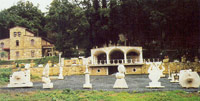 A homage to the element of water that purifies and regenerates matter. As Stefanacci affirms “The pool renders homage to clear water with the waxing moon, strengthened by the sun and honored by the gods; at a distance, the Father, on a column, observing the pool. ”Yet another esoteric exam pie of the primordial forces of nature that Stefanacci has alo “honored” with a series of small and monumentai fountains collocated by the pool with other recently crea ted sculptures. One of the fountains is almost two metres high mounted on a base of three, entitled “Fontana del mondo” (Fountain of the world) in travertine and onyx. A celebration of the seven planets relating to the seven days of the week and the seven colours of Iris framed by hieroglyphics that signify the so verginty over human beings, animals, vegetables and mineral
A homage to the element of water that purifies and regenerates matter. As Stefanacci affirms “The pool renders homage to clear water with the waxing moon, strengthened by the sun and honored by the gods; at a distance, the Father, on a column, observing the pool. ”Yet another esoteric exam pie of the primordial forces of nature that Stefanacci has alo “honored” with a series of small and monumentai fountains collocated by the pool with other recently crea ted sculptures. One of the fountains is almost two metres high mounted on a base of three, entitled “Fontana del mondo” (Fountain of the world) in travertine and onyx. A celebration of the seven planets relating to the seven days of the week and the seven colours of Iris framed by hieroglyphics that signify the so verginty over human beings, animals, vegetables and mineral